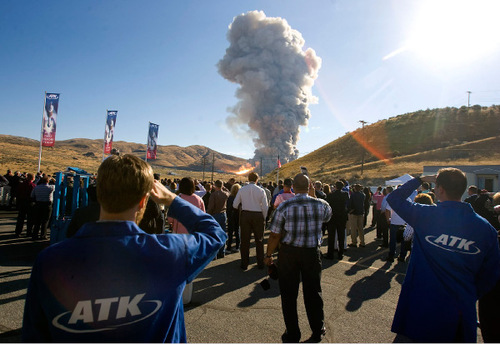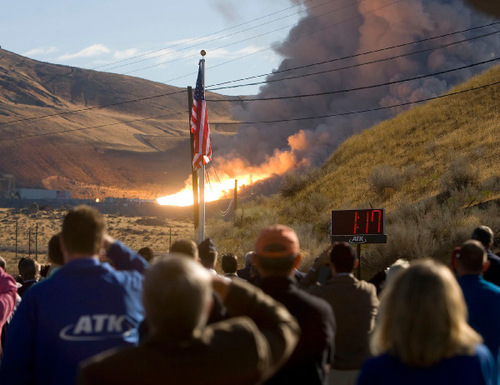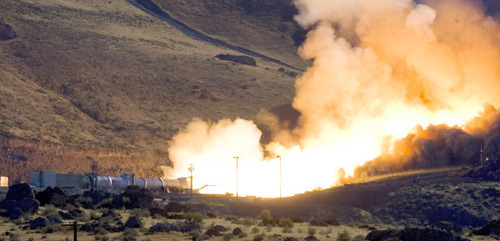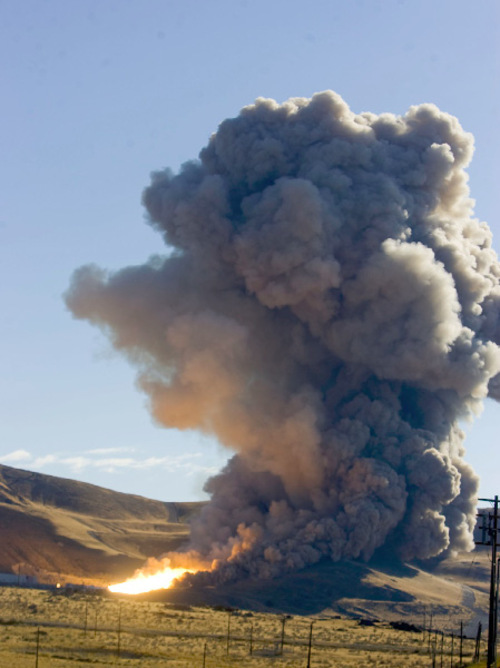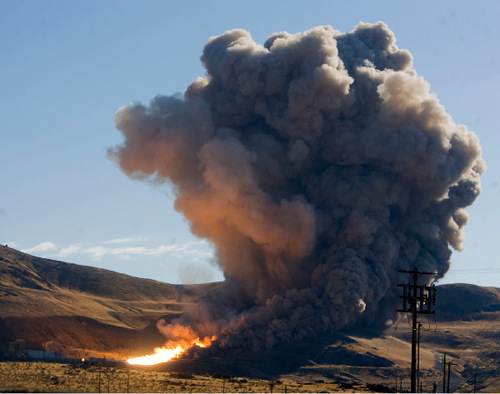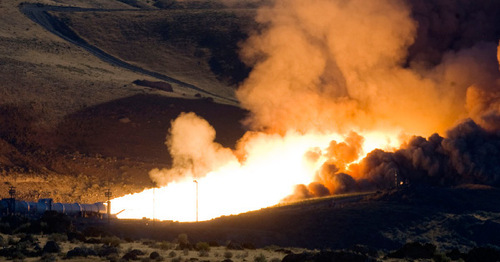This is an archived article that was published on sltrib.com in 2010, and information in the article may be outdated. It is provided only for personal research purposes and may not be reprinted.
Promontory • The crisp air carrying the promise of fall quickly burned away under the flames shooting from the Ares Development Motor at the ATK facility near this rural, desert outpost.
The sound from the engine, which was secured to the ground and stretches from the end zone to the 50-yard line of a football field, roared through the desolate desert air. A plume of smoke and dust billowed thousands of feet into the air, Monday's winds having virtually disappeared to leave the air still and provide an ideal study environment for ATK and NASA scientists.
"We did get a chance to look at the preliminary data, and it looks excellent," said Alex Priskos, manager for the Ares project. "We captured all the data we were after, and we're looking forward to being able to assess it."
But a climate of uncertainty surrounded the test.
NASA and the Obama administration have proposed eliminating the Constellation program, which includes Ares, but the plan is meeting resistance from Congress, including Utah's delegation.
Sen. Orrin Hatch was on hand to watch the firing. He said he has seen some members of the Obama administration and some of his Congress colleagues change their minds about abandoning the manned space program.
"I don't want to be dependent on Russia to get our people in space," Hatch said.
He has helped craft a bill that still includes the need for solid rocket motors to at least launch unmanned vehicles into space, but hopes to keep the manned space program alive.
ATK laid off 800 employees earlier this year, including from its Promontory facility that is in charge of the new booster motors and its Clearfield facility that refurbishes used booster motors.
Hatch hopes to keep ATK and its 3,100 remaining Utah employees in the state.
"We need solid rocket motors, and this is the quintessential solid rocket motor facility in the world," he said.
Doug Cooke, NASA associate administrator, said his agency is still working toward sending people to places such as the moon and Mars.
"The plan that we have in place concentrates on capabilities of human space flight," Cooke said.
The five-stage motor, which is designed to launch the next generation of space-exploration vehicles, was cooled to 40 degrees to test its launching power under cool weather. ATK scientists brought in chillers beginning July 6 to cool the 1.4 million pounds of propellant to 40 degrees.
The motor's first test-firing was last September at 83 degrees, and several changes were made to the rocket after data were collected, said Kent Rominger, ATK Launch Systems vice president of advanced programs. Scientists want to get a range of performances at different temperatures to accurately predict the lift-off capability of the motor in different climates.
Preliminary data looked like it matched up with expectations, but data analysis will begin in two weeks and last for the next year, Priskos said.
A total of 53 different areas were evaluated during the 2 minute and 5 second firing, the force of which could be felt even a mile away as scores gathered to watch the 9:27 a.m. firing. The rocket motor produces a maximum thrust of 3.6 million pounds, or the equivalent of 22 million horsepower. The motor can be used for both crew and cargo missions.
Each test costs about $75 million, Priskos said. So far, nearly $1 billion has been spent during the past five years to develop the first stage. Another test is scheduled for next fall, and has funding from this year. Future tests have yet to be funded in upcoming budgets. —
What's next
P Another test is scheduled for next fall and has funding from this year. Future tests have yet to be funded in upcoming budgets. Each test costs about $75 million. So far, nearly $1 billion has been spent during the past five years to develop the first stage.



